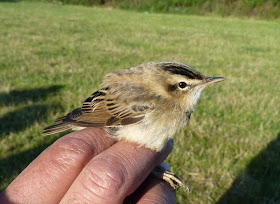Today, Plan A was ringing at Beer Head. I've been desperate to get in a good session up here, so was up there at 5:30 this morning and walked out to my ringing spot. I have absolutely no idea why I bothered walking out there though as the moment I stepped out the car I could see it was far too windy to even contemplate mist netting. Bugger it. Plan B it was then - but I didn't have a plan B! Seeing as I was up, and there was an east wind blowing, I headed to the beach for a sea watch.
I arrived way before dawn, but could already see Gannets streaming east close in. Within an hour and a bit at least 160 Gannets flew by, but sadly not much else did, with just three Common Scoter, one Teal, three Oystercatcher, four Dunlin, two Common Tern (juv and ad) and a Sandwich Tern in the note book.
The best bird was this cracking first-winter Yellow-legged Gull settled on the beach, but sadly it disappeared before the sun came up so apologies for the dull and grainy pic...
 |
| A nice white-headed example |
The sunrise was quite odd. Well there wasn't one due to the cloud cover, but there must have been a gap somewhere as the white cliffs of Beer Head became red...
 |
| No sun anywhere else. Made the chalk look like sandstone! |
I had another look over the sea late morning during a rain shower. There was still very little/nothing passing, but I was pleased to have much better views of the first-winter Yellow-legged Gull on the beach...
Later I saw it again on the Estuary, along with a decent number of Great and Lesser Black-backed Gulls (some of the latter looking very dark backed), 19 Dunlin and 11 Ringed Plover. The biggest surprise was seeing a flock of 14 commic Terns flying rapidly south down river and off out to sea. I got on them too late to ID, and have a feeling we may have missed several more groups doing this as all the Tern passage in south Devon was southward.
And that's pretty much my birding day. So although it didn't go at all to plan, and we missed out on a lot of the action seen elsewhere in Devon, it was still an enjoyable one.
I'll finish this post with a photo I took a few days ago, when the weather was much calmer...
 |
| Taken pre-dawn at Black Hole Marsh |

























